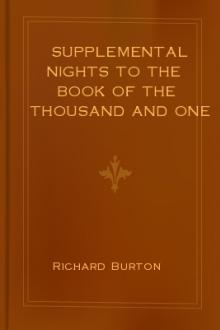The Book of the Thousand Nights and a Night, vol 16, Sir Richard Francis Burton [novels to read for beginners TXT] 📗

- Author: Sir Richard Francis Burton
- Performer: -
Book online «The Book of the Thousand Nights and a Night, vol 16, Sir Richard Francis Burton [novels to read for beginners TXT] 📗». Author Sir Richard Francis Burton
At the end of the Frenchified tale we find a note entitled:—Observations by the French Editor, on the “History of Habib and Dorathil-goase, or the Arabian Knight,” and these are founded not upon the Oriental text but upon the Occidental perversion. It is described “from a moral plane rather as a poem than a simple tale,” and it must be regarded as “a Romance of Chivalry which unites the two chief characteristics of works of that sort,—amusement and instruction.” Habib’s education is compared with that of Telemachus, and his being inured to fatigue is according to the advice of Rousseau in his “Emilius” and the practice of Robinson Crusoe. Lastly “Grandison is a here already formed: Habib is one who needs to be instructed.” I cannot but suspect when reading all this Western travesty of an Eastern work that M.
Cazotte, a typical litt�rateur, had prepared for caricaturing the unfortunate Habib by carefully writing up F�n�lon, Rousseau, and Richardson; and had grafted his own ideas of morale upon the wild stem of the Arabian novel.
Appendix.
NOTES ON THE STORIES CONTAINED IN VOLUME XVI.
By W. F. Kirby.
The Say of Haykar the Sage (Pp.1-30).
Haykar’s precepts may be compared advantageously with those of other nations of the East and West (at a corresponding stage of civilisation) which, as a rule, follow very similar lines. Many of them find their parallels not only in Proverbs and Ecclesiastes, as we might reasonably expect, but even in the Havam�l of the Elder Edda, respecting which Thorpe remarks in his translation (i. p. 36 note): “Odin is the ‘High One.’ The poem is a collection of rules and maxims, and stories of himself, some of them not very consistent with our ideas of a supreme deity.” The style of the Icelandic poem, and the manners of the period when it was composed, are of course as wide apart from those of Haykar as is Iceland from Syria, but human nature remains the same.
Pp. 22-24.—Two classes of subterfuges similar to those employed by Haykar are common in folk-tales. In one, the hero vanquishes, and generally destroys, his adversary (usually a giant) by imposing on his credulity, like Jack when he hid himself in a corner of the room, and left a faggot in his bed for the giant to belabour, and afterwards killed the giant by pretending to rip himself up, and defying the other to do the same. In other cases, the hero foils his opponents by subterfuges which are admitted to be just, but which are not intended actually to deceive, as in the devices by which the blind Shaykh instructs the merchant to baffle the sharpers, in one of the Sindibad stories (vol. vi., pp. 202-212, No. 135x., of our Table). In the present story Pharaoh was baffled by the superior cunning of Haykar but it is not made quite clear whether he actually believed in his power to build a castle in the air or not. However the story probably belongs to the second class.
P. 25.—Twisting ropes out of sand was a device by which Michael Scot baffled a devil for whom he had to find constant employment. (Cf. Scott’s “Lay of the Last Minstrel,” and notes.)
The History of Al-Bundukani (Pp. 31-68).
I believe the “Robber-Caliph” is sometimes played as a burlesque, for which it is well adapted. The parallel suggested between the Caliph and a robber may remind the reader of the interview between Alexander the Great and the Robber, in “Evenings at Home.” One cannot help sympathising with the disappointed young Merchant who acted as an informer, and feeling glad that he got off with a whole skin.
P. 34.—In some versions of this story Harun’s abstention from his bride for a year is attributed to a previous vow.
P. 46 and note 4.—This passage, relative to the character of the Caliph, may be compared with his forgetfulness respecting Nur Al-Din Ali and Anis Al-Jalis. (Vol. ii. p, 42, and note.)
The Linguist-dame, the Duenna, and the King’s Son (Pp.
69-87).
This story, though much shorter, is very closely paralleled by that of Prince Calaf and the Princess of China, in the Thousand and One Days (cf. vol. x., App, pp. 499, 500) Prince Calaf (the son of the King of the Nogais Tartars) and his parents are driven from their kingdom by the Sultan of Carizme (Khw�rizm), and take refuge with the Khan of Berlas, where the old King and Queen remain, while Calaf proceeds to China, where he engages in an intellectual contest with Princess Tourandocte (Turandot, i.e. Tur�ndokht or Turan’s daughter). When Turandot is on the point of defeat, she sends her confidante, a captive princess, to Calaf, to worm out his secret (his own name). The confidante, who is herself in love with Calaf, horrifies him with the invention that Turandot intends to have him secretly assassinated; but although he drops his name in his consternation, he refuses to fly with his visitor. In the morning Turandot declares Calaf’s name to him but comforts him by saying that she has nevertheless determined to accept him as her husband, instead of cutting off his head; and the slave princess commits suicide.
Messengers are then sent for Calaf’s parents, who arrive in company with the friendly Khan who had granted them an asylum; and Calaf marches against the Sultan of Carizme, who is defeated and slain, when his subjects readily submit to the conqueror.
P. 77.—According to Jewish tradition, the Rod of Moses became transformed into so terrible a dragon that the Egyptians took to flight, and 60,000 of them were slain in the press.—(Sale’s Koran, chap. 7, note.) P. 77, note 4.—It was long denied that ants store up grain, because our English ants do not; but it is now well known that many foreign species, some of which inhabit countries bordering on the Mediterranean (including Palestine), store up large quantities of grass seeds in their nests; and one ant found in North America is said to actually cultivate a particular kind of grass.
P. 81, note 6.—Those interested in the question of the succession of the Patriarchs may refer to Joseph Jacobs’ article on “Junior-right in Genesis,”[FN#430] in which the writer argues that it was the original custom among the Hebrews, as among other nations, for the youngest son to succeed to his father’s estates, after the elder ones had already established themselves elsewhere. Much may be urged in favour of this writer’s conclusions, and it will be remembered that our own Monarchy was not recognised as hereditary until the time of the Conquest, the most able or the strongest relative of the late King usually succeeding to the Crown, and minors being always set aside, unless powerful politicians intended to use them as mere tools. In the Esthonian Kalevipoeg the system comes out still more strongly. Three sons are living at home at the time of the death of Kalev, but the youngest is designated by him as his successor, and is afterwards indicated by lot as the peculiar favourite of the gods.
P. 84, note 4.—Although it has nothing to do with the present story, yet I may point out the great importance of the bridle in all the folk-tales which deal with the transformation of human beings into domestic animals. It is clearly implied (though not actually expressed) in the story of Julnar the Sea Born (No. 153) that the power of Abdallah and Badr Basim over Queen Lab, while she bore the form of a mule, depended entirely on their keeping possession of the bridle (cf. Nights, vol. vii., p. 304, and note). There are many stories of magicians who transform themselves into horses, &c., for their friends to sell; but the bridle must on no account be given with the horse. Should this be neglected (purposely or otherwise) the magician is unable to reassume his human form at will. Cf. also Spitta-Bey’s story No. 1 (infr�).
The Tale of the Warlock and the Young Cook of Baghdad (Pp. 95-112).
This story appears in Chavis and Cazotte’s version, and in the various translations made from the French, in a very highly elaborated form, under the title of “The Adventures of Simoustapha, and the Princess Ilsetilsone.” The Caliph and his Wazir are identified with Harun Al-Rashid and Ja’afar, but they suffer no transformations at the hands of the Magician after whose death Prince Simoustapha is protected by Setelpedour Ginatille, whose name is interpreted as meaning the Star of the Seven Seas, though the first name appears rather to be a corruption of Sitt El Bub�r. She is the queen of Ginnistan, and the daughter of Kokopilesobe (Satan), whose contests with Mahomet and Michael (the former of whom continues the conflict by “becoming man”) are described on the approved Miltonic lines. Her chief councillors are Bahlisboull (Beelzebub) and Asmonchar (Asmodeus), but ultimately she falls in love with Simoustapha, and adjures her sovereignty, after which he carries her off, and marries her, upon which the mother of Ilsetilsone, “the sensible Zobeide, formed now a much truer and more favourable judgment of her daughter’s happiness, since she had shared the heart of Simoustapha with Setelpedour, and at last agreed that the union of one man with two women might be productive of great happiness to all the three, provided that one of the wives happened to be a fairy.” (Weber, ii. p. 50.) A most encouraging sentiment for would-be polygamists, truly, especially in Europe, where fairies appear to fly before the advance of civilisation as surely as the wild beasts of the forest!
P. 99.—These apparitions resemble those which usually precede the visions which appear in the well-known pool of ink. But the sweeper is not mentioned in the present story, nor do I remember reading of his appearing in cases of crystal seeing, though Dante Gabriel Rossetti introduces him into his fine poem, “Rose Mary,” as preparing the way for the visions seen in the beryl: “‘I see a man with a besom grey
That sweeps the flying dust away.’
‘Ay, that comes first in the mystic sphere; But now that the way is swept and clear Heed well what next you look on there.’”
P. 104, note 1.—Apropos of the importance of “three days,” I may refer to the “three days and three nights” which Christ is commonly said to have passed in the tomb, and I believe that some mystics assert that three days is the usual period required by a man to recover consciousness after death.
Pp. 106, 107.—These worked lions recall the exhibition of power made by Abu Mohammed hight Lazybones (No. 37; Nights, iv., p. 165). Their Oriental prototypes are probably the lions and eagles with which the Jinn ornamented the throne of Solomon. In the West, we meet with Southey’s amusing legend of the Pious Painter:
“‘Help, help, Blessed Mary,’ he cried in alarm, As the scaffold sunk under his feet; From the canvass the Virgin extended her arm; She caught the good Painter; she saved him from harm; There were hundreds who saw in the street.”
The enchanted palaces of the Firm Island, with their prodigies of the Hart and the Dogs, &c., may also be mentioned (Amadis of Gaul, book II., chap. 21, &c.).
Pp. 107, 108.—Stories of changed sex are not uncommon in Eastern and classical mythology and folk-lore; usually, as in this instance, the change of a man into a woman, although it is the converse (apparent, of course) which we meet with occasionally in modern medical books.
In the Nights,





Comments (0)